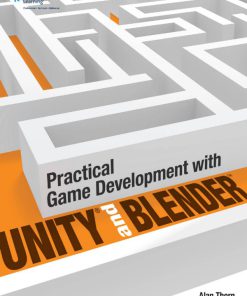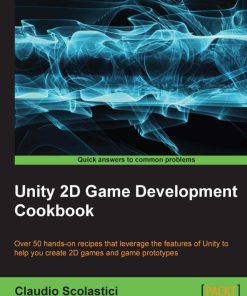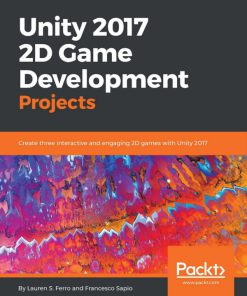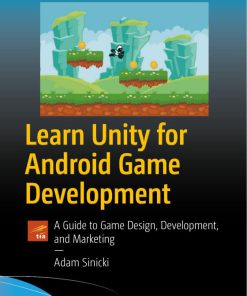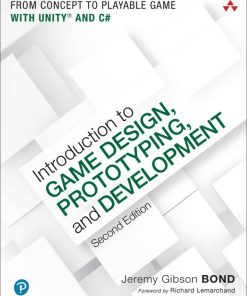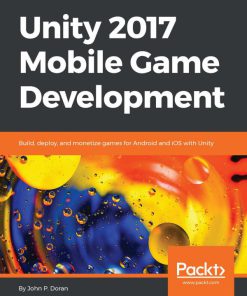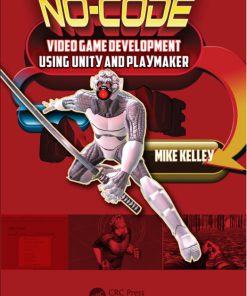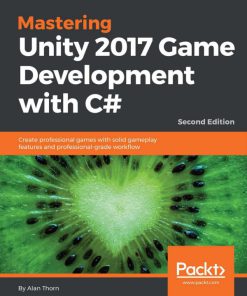(Ebook PDF) Hands On Unity 2020 Game Development Build customize and optimize professional games using Unity 2020 and C# 1st edition by Nicolas Alejandro Borromeo 1838647600 9781838647605 full chapters
$50.00 Original price was: $50.00.$25.00Current price is: $25.00.
Authors:Nicolas Alejandro Borromeo , Series:Gaming [48] , Author sort:Borromeo, Nicolas Alejandro , Languages:Languages:eng , Published:Published:Jul 2020 , Publisher:Packt Publishing
Hands-On Unity 2020 Game Development Build, customize & optimize professional games using Unity 2020 & C# 1st edition by Nicolas Alejandro Borromeo – Ebook PDF Instant Download/DeliveryISBN: 1838647600, 9781838647605
Full download Hands-On Unity 2020 Game Development Build, customize & optimize professional games using Unity 2020 & C# 1st edition after payment.
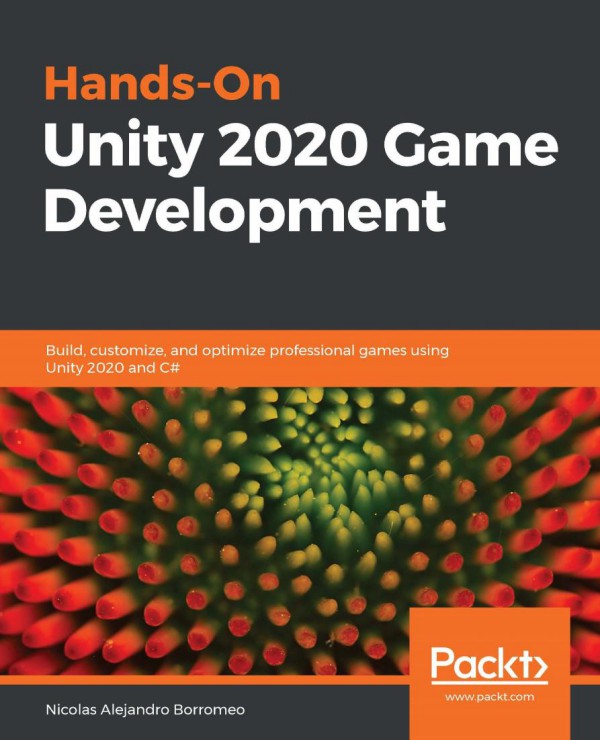
Product details:
ISBN-10 : 1838647600
ISBN-13 : 9781838647605
Author : Nicolas Alejandro Borromeo
Build immersive game experiences using the new Unity 2020 features with this practical guide Key Features Unleash the capabilities of C# scripting for creating immersive UI, graphics, Game AI agents and much more Explore Unity’s latest tools, including Universal Render Pipeline, Shader Graph, and VFX graph, to enhance graphics and animation Get started with building augmented reality experience using Unity’s AR Foundation Book Description Over the years, the Unity game engine has extended its scope from just being about creating video games to building AR/VR experiences, complex simulations, real-time realistic rendering, films, and serious games for training and education. Its features for implementing gameplay, graphics, and customization using C# programming make Unity a comprehensive platform for developing professional-level, rich experiences.
Hands-On Unity 2020 Game Development Build, customize & optimize professional games using Unity 2020 & C# 1st Table of contents:
Chapter 1: Designing a Game from Scratch
Game concept
Input controls
Winning and losing
Game characters
Hero
Enemies
Gameplay
Game-world layout
Starting condition
Ending condition
Point system
HUD
The difficulty balance
Difficulty balance questions
Implementation plan
Documentation
Game Design Document (GDD)
GDD formats
GDD creation tools
Elevator pitch
A high concept
Tips for creating GDDs
Summary
Chapter 2: Setting Up Unity
Why use a game engine such as Unity?
Past and present industry insight
Game engines
Positives of Unity
Installing Unity
Unity versions
Installing Unity with Unity Hub
Creating projects
Creating a project
Project structure
Summary
Chapter 3: Working with Scenes and GameObjects
Manipulating scenes
The purpose of a scene
The Scene View
Our first GameObject
Navigating the Scene View
Manipulating GameObjects
GameObjects and components
Components
Manipulating components
Object hierarchies
Parenting of objects
Possible uses
Prefabs
Creating Prefabs
Prefab-instance relationship
Prefab variants
Saving scenes and projects
Saving our changes
Project structure
Summary
Chapter 4: Grayboxing with Terrain and ProBuilder
Creating a Landscape with Terrain
Discussing Height Maps
Creating and configuring Height Maps
Authoring Height Maps
Adding Height Map details
Creating Shapes with ProBuilder
Installing ProBuilder
Creating a Shape
Manipulating the mesh
Adding details
Summary
Chapter 5: Importing and Integrating Assets
Importing assets
Importing assets from the internet
Importing assets from the Asset Store
Integrating assets
Integrating terrain textures
Integrating meshes
Integrating textures
Configuring assets
Configuring meshes
Configuring textures
Assembling the scene
Summary
Chapter 6: Materials and Effects with URP and Shader Graph
Introducing Shaders
Shader Pipeline
Render Pipelines and URP
URP Built-in Shaders
Creating Shaders with Shader Graph
Creating our first Shader Graph asset
Using Textures
Combining Textures
Applying transparency
Summary
Chapter 7: Visual Effects with Particle Systems and VFX Graph
Introduction to particle systems
Creating a basic particle system
Using advanced modules
Creating fluid simulations
Creating a waterfall effect
Creating a bonfire effect
Creating complex simulations with VFX Graph
Installing VFX Graph
Creating and analyzing a VFX Graph
Creating a rain effect
Summary
Chapter 8: Lighting Using the Universal Render Pipeline
Applying lighting
Discussing lighting methods
Configuring ambient lighting with skyboxes
Configuring lighting in URP
Applying shadows
Understanding shadow calculations
Configuring performant shadows
Optimizing lighting
Understanding static lighting
Baking lightmaps
Applying static lighting to static objects
Summary
Chapter 9: Fullscreen Effects with postprocessing
Using postprocessing
Setting up a profile
Using basic effects
Using advanced effects
Advanced effects
Summary
Chapter 10: Sound and Music Integration
Importing audio
Audio types
Configuring import settings
Integrating and mixing audio
Using 2D and 3D AudioSources
Using an Audio Mixer
Summary
Chapter 11: User Interface Design
Understanding Canvas and RectTransform
Creating a UI with Canvas
Positioning elements with RectTransform
Canvas objects types
Integrating assets for the UI
Creating UI controls
Creating a responsive UI
Adapting objects’ positions
Adapting objects’ sizes
Summary
Chapter 12: Creating Animations with Animator, Cinemachine, and Timeline
Using skeletal animations with Animator
Understanding skinning
Importing skeletal animations
Integration using Animation Controllers
Creating dynamic cameras with Cinemachine
Creating dolly tracks
Creating cutscenes with Timeline
Creating animation clips
Sequencing our intro cutscene
Summary
Chapter 13: Introduction to Unity Scripting with C#
Creating C# scripts
Initial setup
Creating a MonoBehaviour-based class
Adding fields
Using events and instructions
Events and instructions
Using fields in instructions
Common beginner errors
Summary
Chapter 14: Implementing Movement and Spawning
Implementing movement
Moving objects through Transform
Using Input
Understanding Delta Time
Implementing spawning
Spawning objects
Timing actions
Destroying objects
Summary
Chapter 15: Physics Collisions and Health System
Configuring Physics
Setting shapes
Physics Object types
Filtering collisions
Detecting collisions
Detecting Trigger events
Modifying the other Object
Moving with Physics
Applying forces
Tweaking Physics
Summary
Chapter 16: Win and Lose Conditions
Creating Object Managers
Implementing the Singleton design pattern
Creating Managers with Singleton
Creating Game Modes
Improving our code with events
Summary
Chapter 17: Scripting the UI, Sounds, and Graphics
Scripting the UI
Showing information in the UI
Programming the Pause menu
Scripting feedback
Scripting visual feedback
Scripting audio feedback
Scripting animations
Summary
Chapter 18: Implementing Game AI for Building Enemies
Gathering information with sensors
Creating Three-Filters sensors
Debugging with Gizmos
Making decisions with FSMs
Creating the FSM
Creating transitions
Executing FSM actions
Calculating our scene Pathfinding
Using Pathfinding
Adding final details
Summary
Chapter 19: Scene Performance Optimization
Optimizing graphics
Introduction to graphic engines
Using Frame Debugger
Using batching
Other optimizations
Optimizing processing
Detecting CPU- and GPU-bound
Using the CPU Usage profiler
General CPU optimization techniques
Optimizing memory
Memory allocation and the garbage collector
Using the Memory Profiler
Summary
Chapter 20: Building the Project
Building a project
Debugging the build
Debugging code
Profiling performance
Summary
Chapter 21: Finishing Touches
Iterating your game
Testing and feedback
Interpreting feedback
Releasing your game
Pre-release
Release
Post-release
Summary
Chapter 22: Augmented Reality in Unity
Using AR Foundation
Creating an AR Foundation project
Using tracking features
Building for mobile devices
Building for Android
Building for iOS
Creating a simple AR game
Spawning the Player and Enemies
Coding the Player and Enemy behavior
People also search for Hands-On Unity 2020 Game Development Build, customize & optimize professional games using Unity 2020 & C# 1st:
hands on unity 2021 game development
hands-on unity 2022 game development
hands-on unity 2020 game development
2d unity game development
unity game development 2d




